The Pre-History of Scioto County
Posted: Tue Jul 29, 2008 3:30 am
The recorded history of Scioto county goes all the back to the 1700's when the settlers first started arriving and settling in the area, but this area has had occupation going back as far as 10,000 to 12,000 years ago. I have collected Indian artifacts for 43 of my 49 years I've been on this planet and our area is rich in Indian culture, villages, mounds, and artifacts. There isn't a plowed field anywhere in Scioto county where you can't find evidence of Indians once being there, whether it be traces of flint chips or actual arrowheads and other artifacts. I have pieces that date from 10,000 to 8,500 BC (Paleo culture) all they way up to the mid 1600's (Ft Ancient culture).
First Americans, Paleo Culture 12,000 to 8,500 BC
The Paleo people are considered to be the first people to inhabit our continent and it has always been said they came across the Bering Strait and down through Alaska and then spread out through the country. There is now specualtion and some evidence of some people possibly arriving from Europe on the east coast at around the same time and possibly earlier. The Paleo people were hunter gatherers that were for the most part nomadic. They had camps, but nothing actually permanent, since they followed the game which consisted of the Mammoth, the Giant Sloth, and the Saber Tooth Tiger among others. They may have used some camps over and over as they went through an area, but they didn't have actual villages per se. Paleo culture is most famous for their point styles known as Fluted Points since they would chip channels or flutes out of one or both faces of the point. Some people speculate this was for better hafting while others say it was so the blood would flow more freely from the animal and it would die quicker.
These are typical Paleo Points.
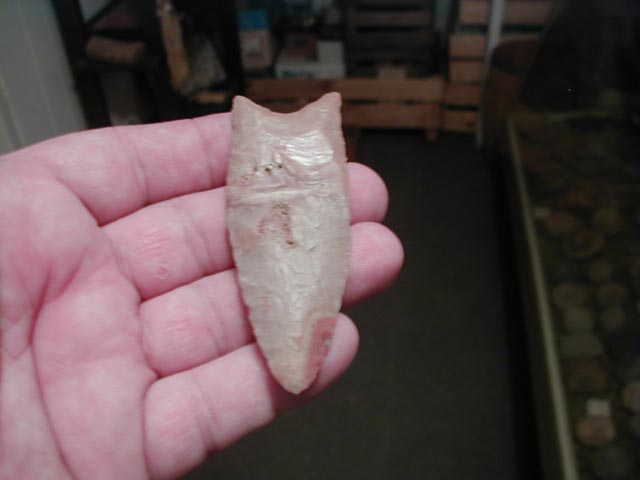

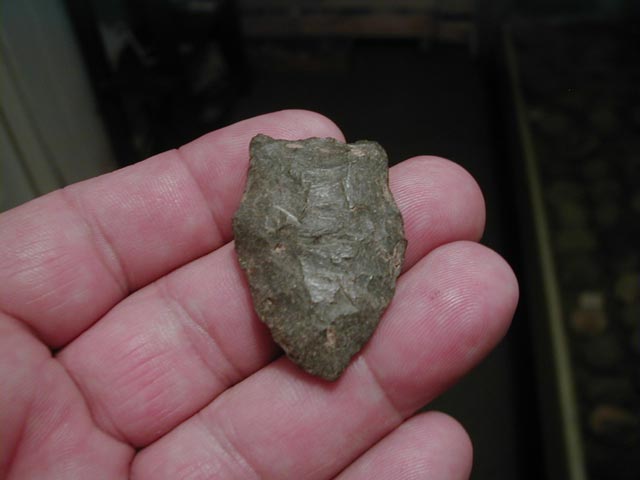

The Archaic Culture, 8,500 BC to 2,500 BC
Do to changes in the enviroment and the ever decreasing amount of game the Paleo culture slowly died out and was replaced by the Arcahic people who were more settled and a lot less nomadic. Like the Paleoindians before them, Archaic people hunted large and small game animals, fished in the lakes and streams, and gathered nuts and berries. During the early part of the Archaic Period people were always on the move. Their shelters were tents made from wooden poles covered with bark or hides. Later in this period some groups began to settle down and focus on certain rich resources such as nuts or shellfish. They built sturdier houses and dug pits alongside for storing nuts and other foods.
One of the Archaic people's more important natural resources was flint. They mined flint from several sources, but in Ohio, their favorite flints continued to be Upper Mercer flint from Coshocton County and Flint Ridge flint from Licking County. Tools made from flint supplied many of their needs, but new kinds of tools were added to the Archaic toolbox.
Archaic people made sturdy axes from hard stone such as granite. They used these axes to chop down trees and shape the wood into dugout canoes and other useful forms. They also carved and polished pieces of a rock called slate making them into a variety of shapes. Many of these artistic carvings were used as weights or decorations for their spear-throwers. A spear-thrower, or atlatl, is a wooden shaft with a handle at one end and a hook at the other. The spear-thrower was used to catapult spears much farther and with more force than if they were thrown with the unaided arm.
Here are some typical Archaic pieces.






The Woodland Culture, 2,500 BC to 600 AD
The Woodland Culture included both the Adena and the Hopewell peoples, or as they are more commonly refered to by some, the Mound Builders. The Portsmouth area was hotbed of activity during this time period with numerous large and extravagant mounds being built in the area. The most famous ones being Tremper Mound, The Medicine Wheel, and of course the Horseshoe Mounds of which one is still left in Mound Park. There were probably hundreds of Mounds in Scioto county at one time, but almost all of them have been destroyed by either farming or constuction. Even the Horseshoe Mound in Mound Park isn't an original and is instead a replica of one of the originals. Tremper Mound was most famous for the wealth of artifacts that were found buried within it's confines, including hundreds of Effigy Pipes that had been ceremoniously killed and buried in a Cache. The Adena and Hopewll cultures lived in huge villages and farmed, fished, hunted, and gathered nuts and berries in a specific area. They had very large and far flung trade routes that extended all the way to the north for copper from upper Michigan to the Gulf Coast region for shells to make ornaments and Beads. They even obtained obsidian from the west to make some of their ceremonial Knifes and Blades.
Typical Adena Points are stemmed and like the ones at 12, 3, 6, and 9 in this picture.

Typical Hopewell Points and artifacts are like these.




The Ft Ancient Culture, 600 AD to 1650 AD
The Ft Ancient culture was also very prevelant in Scioto county and the surrounding areas. I know of at least 5 or 6 Ft Ancient villages located with a few minutes drive of Portsmouth in every direction. The one probably most famous is The Fuert Village and Mounds located just north of Portsmouth on the terrace where UPS and the Dog Pound set. This was a huge village at one time and even though it was excavated a long time ago and on numerous occasions, it is still giving up artifacts in a dig that is ongoing right now. The Ft Ancient people also had very large villages and they hunted, fished, farmed and lived in the same areas for hundreds of years. A lot of their villages were surrounded by huge circular walls of logs stuck into the ground for protection from attacks by other villages. Their diet consisited of a lot of fish and mussels which is evident by the huge amounts of fish bones and mussel shells that are found in the trash pits, or middens. The arrowheads were for the most part triangular in shape, some serrated, and were very thin and sharp. They also made numerous different types of Beads out of shell, bone, and copper. They made all kinds of types of Pipes as well and these were made from different materials such as sandstone and Ohio Pipestone which can be found in the hills right above Clay High School.
Here are some typical Ft Ancient artifacts including points, drills, beads, pipes, bone tools, pottery, etc.
These first four are all from the Fuert Site.
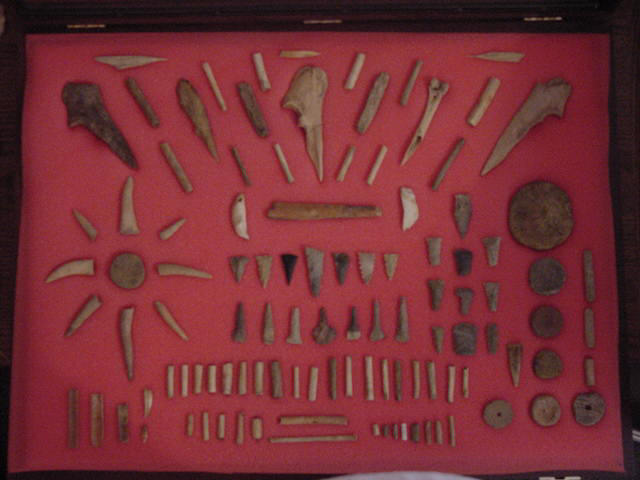
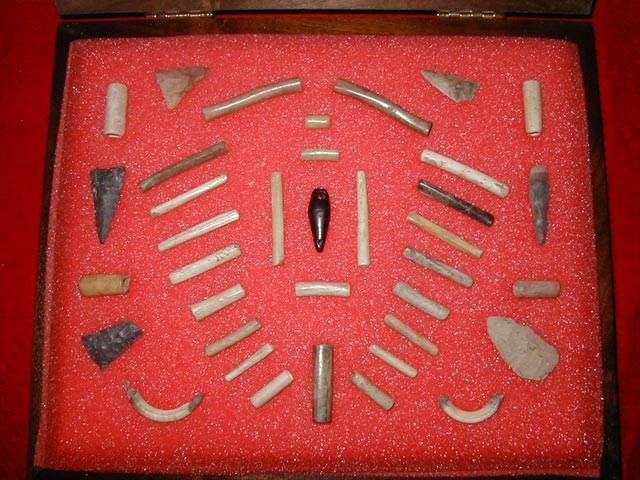


These are from the Goldcamp Site which is in Lawrence County.





These are from the Hardin Village Site which is in Greenup County, Ky.

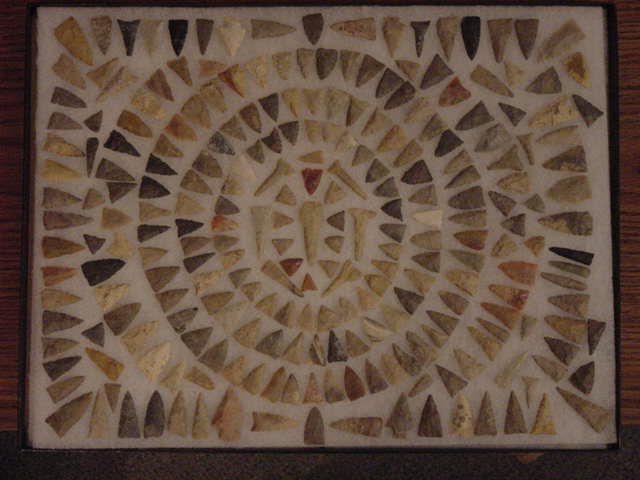


These are from the Schisler Site located just south of Lucasville behind the ODOT garage.
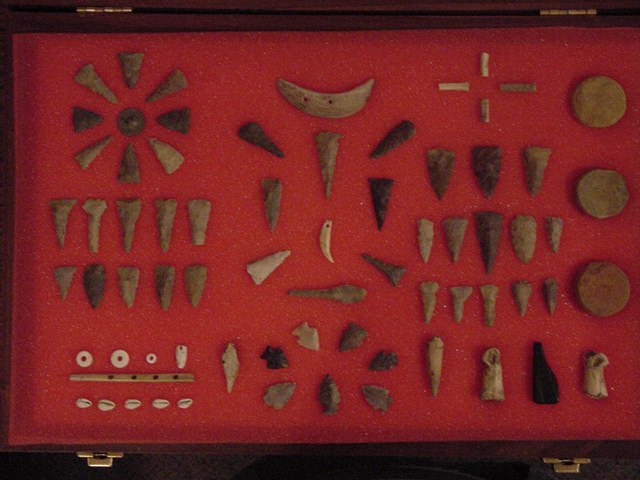
This is from a small village site close to Wheelersburg.

First Americans, Paleo Culture 12,000 to 8,500 BC
The Paleo people are considered to be the first people to inhabit our continent and it has always been said they came across the Bering Strait and down through Alaska and then spread out through the country. There is now specualtion and some evidence of some people possibly arriving from Europe on the east coast at around the same time and possibly earlier. The Paleo people were hunter gatherers that were for the most part nomadic. They had camps, but nothing actually permanent, since they followed the game which consisted of the Mammoth, the Giant Sloth, and the Saber Tooth Tiger among others. They may have used some camps over and over as they went through an area, but they didn't have actual villages per se. Paleo culture is most famous for their point styles known as Fluted Points since they would chip channels or flutes out of one or both faces of the point. Some people speculate this was for better hafting while others say it was so the blood would flow more freely from the animal and it would die quicker.
These are typical Paleo Points.




The Archaic Culture, 8,500 BC to 2,500 BC
Do to changes in the enviroment and the ever decreasing amount of game the Paleo culture slowly died out and was replaced by the Arcahic people who were more settled and a lot less nomadic. Like the Paleoindians before them, Archaic people hunted large and small game animals, fished in the lakes and streams, and gathered nuts and berries. During the early part of the Archaic Period people were always on the move. Their shelters were tents made from wooden poles covered with bark or hides. Later in this period some groups began to settle down and focus on certain rich resources such as nuts or shellfish. They built sturdier houses and dug pits alongside for storing nuts and other foods.
One of the Archaic people's more important natural resources was flint. They mined flint from several sources, but in Ohio, their favorite flints continued to be Upper Mercer flint from Coshocton County and Flint Ridge flint from Licking County. Tools made from flint supplied many of their needs, but new kinds of tools were added to the Archaic toolbox.
Archaic people made sturdy axes from hard stone such as granite. They used these axes to chop down trees and shape the wood into dugout canoes and other useful forms. They also carved and polished pieces of a rock called slate making them into a variety of shapes. Many of these artistic carvings were used as weights or decorations for their spear-throwers. A spear-thrower, or atlatl, is a wooden shaft with a handle at one end and a hook at the other. The spear-thrower was used to catapult spears much farther and with more force than if they were thrown with the unaided arm.
Here are some typical Archaic pieces.






The Woodland Culture, 2,500 BC to 600 AD
The Woodland Culture included both the Adena and the Hopewell peoples, or as they are more commonly refered to by some, the Mound Builders. The Portsmouth area was hotbed of activity during this time period with numerous large and extravagant mounds being built in the area. The most famous ones being Tremper Mound, The Medicine Wheel, and of course the Horseshoe Mounds of which one is still left in Mound Park. There were probably hundreds of Mounds in Scioto county at one time, but almost all of them have been destroyed by either farming or constuction. Even the Horseshoe Mound in Mound Park isn't an original and is instead a replica of one of the originals. Tremper Mound was most famous for the wealth of artifacts that were found buried within it's confines, including hundreds of Effigy Pipes that had been ceremoniously killed and buried in a Cache. The Adena and Hopewll cultures lived in huge villages and farmed, fished, hunted, and gathered nuts and berries in a specific area. They had very large and far flung trade routes that extended all the way to the north for copper from upper Michigan to the Gulf Coast region for shells to make ornaments and Beads. They even obtained obsidian from the west to make some of their ceremonial Knifes and Blades.
Typical Adena Points are stemmed and like the ones at 12, 3, 6, and 9 in this picture.

Typical Hopewell Points and artifacts are like these.




The Ft Ancient Culture, 600 AD to 1650 AD
The Ft Ancient culture was also very prevelant in Scioto county and the surrounding areas. I know of at least 5 or 6 Ft Ancient villages located with a few minutes drive of Portsmouth in every direction. The one probably most famous is The Fuert Village and Mounds located just north of Portsmouth on the terrace where UPS and the Dog Pound set. This was a huge village at one time and even though it was excavated a long time ago and on numerous occasions, it is still giving up artifacts in a dig that is ongoing right now. The Ft Ancient people also had very large villages and they hunted, fished, farmed and lived in the same areas for hundreds of years. A lot of their villages were surrounded by huge circular walls of logs stuck into the ground for protection from attacks by other villages. Their diet consisited of a lot of fish and mussels which is evident by the huge amounts of fish bones and mussel shells that are found in the trash pits, or middens. The arrowheads were for the most part triangular in shape, some serrated, and were very thin and sharp. They also made numerous different types of Beads out of shell, bone, and copper. They made all kinds of types of Pipes as well and these were made from different materials such as sandstone and Ohio Pipestone which can be found in the hills right above Clay High School.
Here are some typical Ft Ancient artifacts including points, drills, beads, pipes, bone tools, pottery, etc.
These first four are all from the Fuert Site.




These are from the Goldcamp Site which is in Lawrence County.





These are from the Hardin Village Site which is in Greenup County, Ky.




These are from the Schisler Site located just south of Lucasville behind the ODOT garage.

This is from a small village site close to Wheelersburg.





















